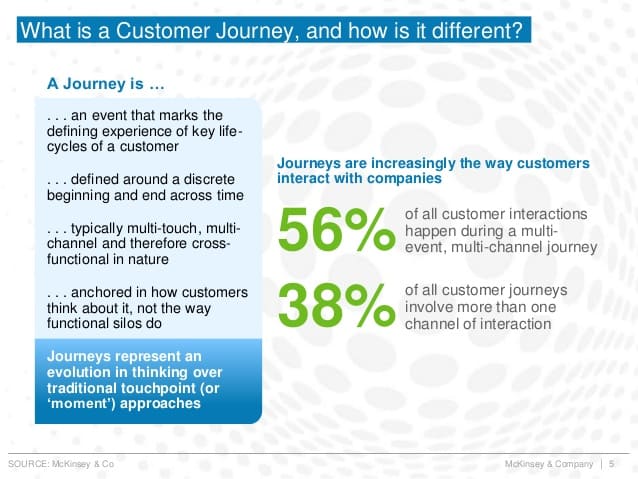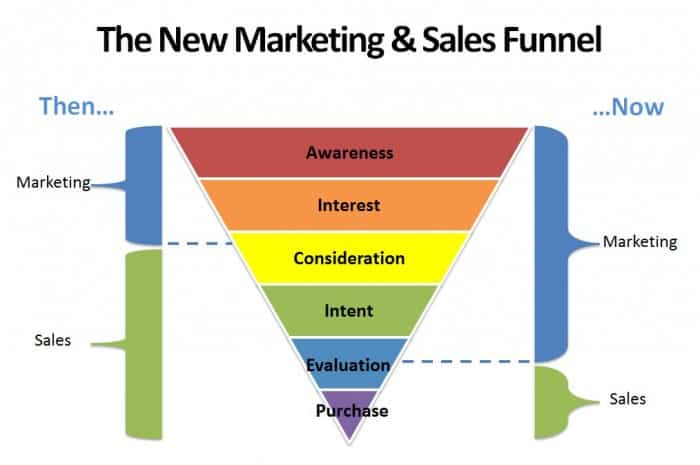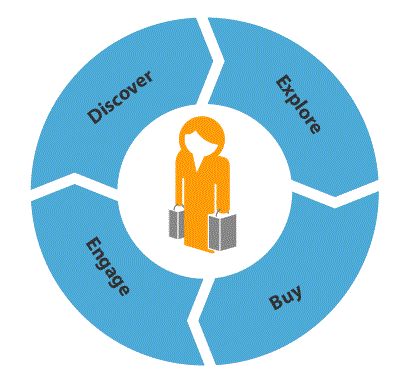A pivotal concept of marketing and sales is the funnel – through which companies systematically move prospects along the buyer’s journey from awareness through consideration and on to purchase. But with prospects now better educated, connected, and empowered than ever, the funnel is also dramatically and rapidly changing. Can marketers still rely solely on the funnel? Our data suggests otherwise. Here’s how to optimize conversions on non-linear marketing funnels:
The funnel is part of the buyer’s journey, also known as the customer journey, which has significantly changed due to technology and access to information. Plenty of research has been written about it by top research bodies such as Forrester and CEB. They seem to agree that most of the purchase decision is complete before a customer even contacts a vendor or brand. Furthermore, the journey now spreads over more channels and events, making attribution even harder than before. Here is a good summary by McKinsey & Co.:
 Since attribution across the different channels is so difficult, marketers tend to focus on what they can monitor and manipulate: how prospective customers behave when they appear as anonymous visitors at their online doorstep – or as we humans call it, the website. Here, in a more controlled environment, online marketers constantly improve the output of their funnel through optimization of every part of it. And since everything is supposed to be measurable and under control, the changing nature of the marketing funnel is felt the most.
Since attribution across the different channels is so difficult, marketers tend to focus on what they can monitor and manipulate: how prospective customers behave when they appear as anonymous visitors at their online doorstep – or as we humans call it, the website. Here, in a more controlled environment, online marketers constantly improve the output of their funnel through optimization of every part of it. And since everything is supposed to be measurable and under control, the changing nature of the marketing funnel is felt the most.
Some look at the new funnel as a change to the traditional roles of the team. Steve Patrizi sees it this way:

Others criticize him for sticking to a linear line of thinking. Mark Bonchek and Cara France posited on Harvard Business Review that “the primary problem with the funnel is that the buying process is no longer linear. Prospects don’t just enter at the top of the funnel; instead, they come in at any stage. Furthermore, they often jump stages, stay in a stage indefinitely, or move back and forth between them.”
Forrester also bid their farewell to the funnel altogether, and offered this in exchange:

Others have also contributed their creative graphical abilities, as seen by a simple search of “marketing funnel” in Google images:

Above, you can actually see the different theories, but what does the data tell us? Let’s look at some evidence.
 Exhibit B
Exhibit B BrightInfo was built to address the new non-linear funnel by dynamically offering the right content (locked or not) to each visitor at the right time (we call this content targeting). By clicking on these content recommendations, visitors are redirected to premium content landing pages where they fill out a form.
BrightInfo was built to address the new non-linear funnel by dynamically offering the right content (locked or not) to each visitor at the right time (we call this content targeting). By clicking on these content recommendations, visitors are redirected to premium content landing pages where they fill out a form.
Putting it back into funnel context – this is a way to shorten the funnel and take the visitor directly to the right content. This is what Google Analytics would register as an assist, and what Mark Bonchek and Cara France call jumping stages. So, this is one way to understand that the marketing funnel is no longer linear.
Another data point is the exit BrightBox – where visitors showed exit intent, but were engaged with a good enough offer to change their mind. Reacting in real-time to a visitor’s behavior helps to optimize conversions on all stages of the funnel – especially when it’s not linear. As you can see in exhibit B, in some sites this is the majority of leads!
Furthermore, an internal breakdown we ran on exit-intent popups shows that up to 20 percent of leads we generate can come directly from lead capture widgets. These popups and slide-ins do not offer content, but rather recognize that the visitor is engaged – for example, having read 2 blog posts – and is ready to leave a few details to keep in touch. Other lead captures act as a virtual gate to free content – turning each blog post into a premium content lead generator. These leads are even more disruptive to the concept of the marketing funnel since they come from webpages where normally you cannot natively convert at all.
BrightInfo’s data makes it pretty clear that the marketing funnel is no longer linear. Today’s customer journey is fragmented and may take several different visits to the website to advance their interest level. Why should visitors be forced to re-expreience the same funnel they did not find appealing the first time? Real-time personalization, also known as content targeting, makes every touch point on the website a unique experience based upon the visitor’s most recent online behavior. This can generate more conversions, lower the cost of leads by up to 90 percent and – most importantly - make every visit relevant to the prospective customer.